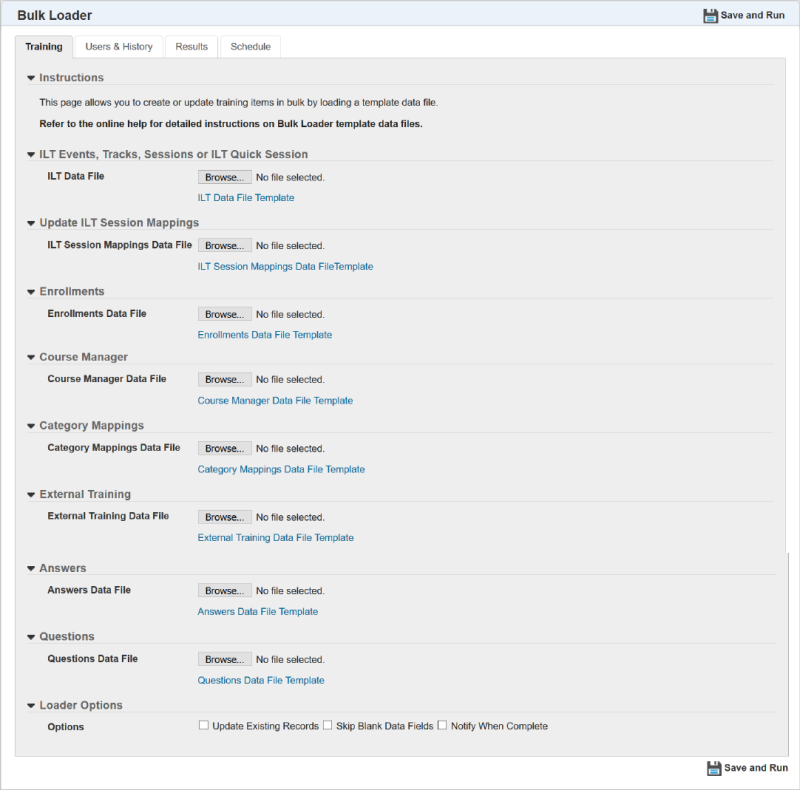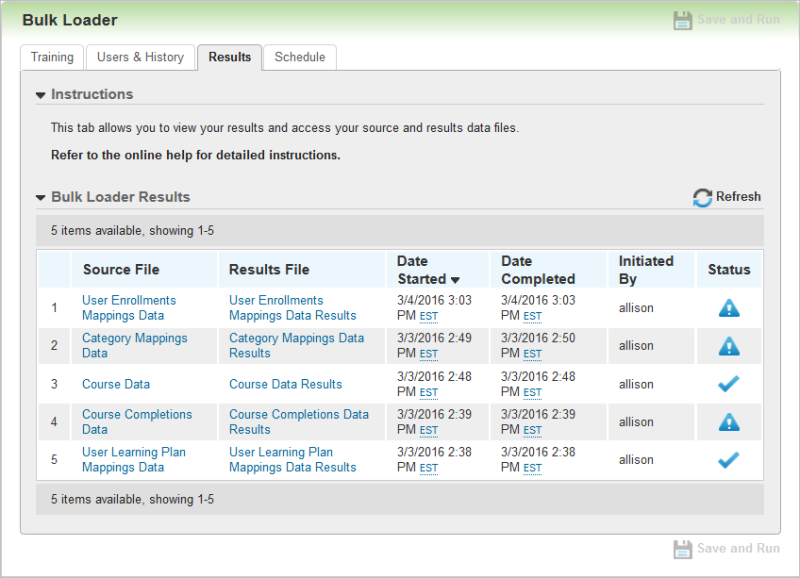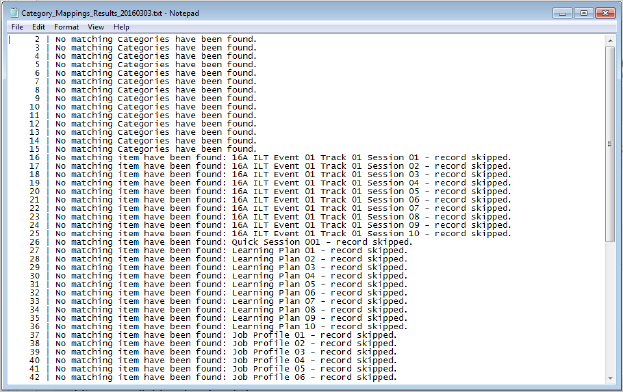Bulk Loader
Bulk Loader lets you quickly bulk-create or update various LearnCenter training items, bulk-map Users to training, bulk-create and update User training history, and bulk-create and mange schedules for automatic loads from third party systems. All of these tasks can be done using standard template files that are provided for download right on the Bulk Loader page.

|
The following User Permission is required to view and use this feature: Manage Bulk Loader, sub Permission of Manage Integrations.
See User Permissions and Integrations User Permissions for instructions on granting and denying these User Permissions.
|
Bulk Loader is particularly useful if you have very large numbers of items to create, update,map, or manage, because it significantly reduces the amount of time and effort needed to complete these tasks. Use cases for using Bulk Loader might include things like:
- The ongoing loading of ILT or Enrollment data.
- Mapping a large number of Users to ILT Sessions or Enrollments.
- The creation of historical Enrollment information from a legacy LMS,
- A company-wide initiative to have hundreds or thousands of Users mapped to certain Enrollments within a short time frame.
- Perhaps your organization has moved and you need to update all of your Enrollments with new Location information.
- Change your ILT Enrollments to be included or excluded from Advanced Search.
- Load data from third party training sites like third party web-based training completions, or third party badge readers from ILT sessions and attach that information to Enrollments.
All of these can be achieved easily and quickly with Bulk Loader. You can even schedule these processes to happen at certain intervals without much intervention from you. See Process for Using Bulk Loader for instructions on using this feature.

|
Bulk Loader performance is optimized to process source files that have a maximum of 5000 rows. |
On the Control Panel:
- Click
 on the Integrations menu to expand it.
on the Integrations menu to expand it.
- Click Bulk Loader.The Bulk Loader is organized into four tabs to logically organize and display the various loader types.
- Select the Training tab if you want to bulk-create or update training items and category mappings.

- Select the appropriate loader from this tab. The top portion of this page provides you with access to the templates you need to create or update your data. It also provides you with the mechanism for uploading that data to LearnCenter. The available loaders for this tab are:
- ILT Events, Tracks, Sessions or ILT Quick Session – Enables you to bulk-create new or update existing ILT Events, LT Tracks, and ILT Sessions as well as the ILT Quick Session. See Process for Using Bulk Loader and ILT Data Requirements for instructions on using the template.
- Update ILT Session Mappings - Enables you to remap existing ILT Sessions to new Tracks or Events. You can also take Quick Sessions and put them under Events and Tracks, or take items that are under Events or Tracks and make them Quick Sessions. This is the only place in LearnCenter that has this type of functionality. See Process for Using Bulk Loader and ILT Data Requirements for instructions on using the template.
- Enrollments - Enables you to bulk-create new or update existing ILT, Course, Class, and Self Study Enrollments. See Process for Using Bulk Loader and Enrollment Data Requirements for instructions on using the template.
- Course Manager – Enables you to bulk-create new LearnCenter Courses or bulk-update existing Courses. You can also create Courses based on template Courses they have already created. See Process for Using Bulk Loader and Course Manager Requirements for instructions on using the template.
- Category Mappings – Enables you to bulk-map items to Categories or bulk-remove items from Categories. This reduces the amount of manual labor involved in mapping and un-mapping large amounts of training items. See Process for Using Bulk Loader and Category Mapping Requirements for instructions on using the template.
- External Training - Enables you to create new, or update existing External Training in bulk. You can also use it to manage mange the adding and updating of Users’ External Training completions from a single bulk to Users’ External Training completions from a single bulk loader.
- Answers - Enables you to upload and manage Answers for use with the Assessments/Surveys feature.
- Questions - Enables you to upload and manage Questions for use with the Assessments/Surveys feature.
- Select any of the following from the Loader Options section:
- Update Existing Records - By default, the Bulk Loader will only create new records when this check box is selected. This indicates that you want to take two actions:
- To create new records
AND
- To update existing records that match the items in your data file.
This safeguard prevents you from accidentally overwriting events. Note that in general, LearnCenter does not enforce unique training item names. If the Bulk Loader finds more than one training item record with the exact same name, it will generate an error in the results file to call that situation to your attention in order to give you the option to update the training item names to be unique and rerun the data file. Also this option has no effect in the case of Enrollment Users, as the only operation performed there is mapping (enrolling) to the Enrollment.
- Skip Blank Data Fields - enables you to only update certain fields across many events. For example, to update the Location for multiple sessions, just input the names of the events you are changing and only put data in the Location column. Columns with no data are skipped for all of these events. Only the columns with data are changed.
- Notify When Complete. - When you upload data, the generation of your data is queued up behind other jobs, so it may not complete right away. Selecting this option indicates that you want to receive a notice to tell you when the data generation is complete. You can then view a results file and see if the upload was successful or if there were errors.
OR
- Select the Users & History tab if you want to manage the mapping of Users to training items and their history. You can create User history or update past, present, and future completions.

- Select the appropriate loader from this tab. The top portion of this page provides you with access to the templates you need to create or update your data. It also provides you with the mechanism for uploading that data to LearnCenter. The available loaders for this tab are:

|
Bulk Loader does not support the use of past completions with recurring Learning Plans. |

|
As a best practice with recurring Learning Plans, it is recommended that you do the following: First ensure that Users are not yet assigned to the recurring Learning Plans you are loading. Next, load their Course completions in date order; oldest to newest. Finally, assign Users to the recurring Learning Plans. |
- User Enrollment Mapping - Enables you to bulk-create or update User Enrollment mappings and / or completions related to ILT, Course, Class, or self-study, Enrollments. See Process for Using Bulk Loader and Enrollment User Data Requirements for instructions on using the template.
- Course Completions - Enables you to bulk-create or update User’s Course mappings and completions for AICC, SCORM, LearnCenter Courses. See Process for Using Bulk Loader and Course Completion Requirements for instructions on using the template.
- User Supervisor Mappings - Enables you to bulk upload Supervisors, map Supervisors to Supervisor Roles, and Map and un-map Users to the Supervisors.
- Select any of the following from the Loader Options section:
- Update Existing Records - By default, the Bulk Loader will only create new records when this check box is selected. This indicates that you want to take two actions:
- To create new records
AND
- To update existing records that match the items in your data file.
This safeguard prevents you from accidentally overwriting events. Note that in general, LearnCenter does not enforce unique training item names. If the Bulk Loader finds more than one training item record with the exact same name, it will generate an error in the results file to call that situation to your attention in order to give you the option to update the training item names to be unique and rerun the data file. Also this option has no effect in the case of Enrollment Users, as the only operation performed there is mapping (enrolling) to the Enrollment.
- Skip Blank Data Fields - enables you to only update certain fields across many events. For example, to update the Location for multiple sessions, just input the names of the events you are changing and only put data in the Location column. Columns with no data are skipped for all of these events. Only the columns with data are changed.
- Notify When Complete. - When you upload data, the generation of your data is queued up behind other jobs, so it may not complete right away. Selecting this option indicates that you want to receive a notice to tell you when the data generation is complete. You can then view a results file and see if the upload was successful or if there were errors.
- Select the Results tab to view all of the data upload attempts you or other Administrators have made.

It also provides you with access to the Source Files that you created and uploaded and the Results File for your upload, which can include information about errors that occurred during the upload process). You can click the up/down arrow at the top of the Date Started and Date Completed columns to sort the results in ascending or descending order by started or completed date and time. You can click the hyperlinks for the Source files and the Results files to display or download them. You will notice that both file types have a naming convention that includes their run dates. This helps you to identify them should you decide to save them on your hard drive. Tip: you can match up the rows in the Source File and the Results files to give you an understanding of what was done for every row of information when the Source File was uploaded.

|
Both the Source File and the Results file can be up to 10 Mb in size.
The last 10 Source and Results files for each Loader are available on this page. Files beyond 10 are purged from the system on a weekly basis.
Best Practice: It is a best practice to download the source and results for each load to your local computer.
|
- Source File – The original data file uploaded to the loader with a date stamp adde
- Results File – The results of the loader, there will be one line for every line in the source file.Click the Results File hyperlink to open the results page and see more detail.

The results file will have one row in the output for every row in the source data file to allow for each matching of any error conditions.
- Date Started (default sort order) - shows the most recently run file at the top of the list in the Users date and time setting.
- Date Completed – Shows the date the file completed in the Users date and time setting. The column will be blank while a file is pending or running into the system.
- Refresh button - If the file is still processing (
 ), you can click the Refresh button to see if it is done.
), you can click the Refresh button to see if it is done.
- Initiated by - enables you to see which Admin started a load.
- Status icons alert you to whether the file loaded successfully (
 ), with errors (
), with errors ( ) or is still processing (
) or is still processing ( ).
).
File Purge
Files are purged every Sunday night. The most recent 10 runs are saved.

|
This number can be raised to as high as 50. Customer Support throughContact Customer Support through My Oracle Support My Oracle Support and open an SR requesting to change the Bulk Loader Table Value if you would like this number changed.. |
 Related Topics
Related Topics

Copyright © 2010-2018, Oracle and/or its affiliates. All rights reserved.
 on the
on the 



 ), you can click the
), you can click the  ), with errors (
), with errors ( ) or is still processing (
) or is still processing ( Related Topics
Related Topics